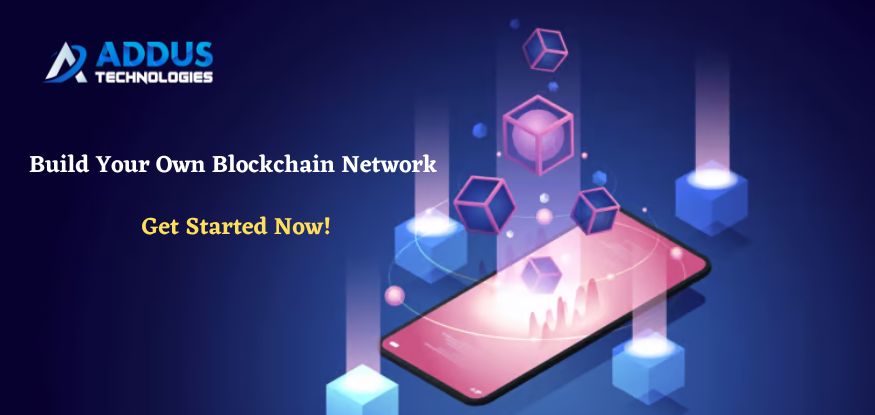Build Your Own Blockchain Network – Get Started Now!

Blockchains are assured to shape the future, with immense potential to transform various industries, much like electricity and the internet did. Currently, in its early stages, blockchain technology is undergoing widespread development worldwide to bolster its adoption. Key players like Hyperledger, Corda, and Ethereum are actively addressing challenges to accelerate the acceptance and implementation of blockchain. These advancements aim to propel the rate of blockchain adoption, revolutionizing numerous aspects of our lives.
Blockchain Network – Overview
The development of blockchain involves the creation of a secure, decentralized ledger technology that records and tracks transactions and assets across a network. This technology has significant value across various industries due to its ability to facilitate fast, accurate, and secure information sharing. Whether it’s monitoring orders, accounts, payments, production, or any other data, a blockchain network provides transparent delivery and storage for authorized members of the network.
Various types of Blockchain Network
Blockchains can be categorized into three types:
Private Blockchain Network – utilized within specific internal networks with known users (e.g., Hyperledger Fabric);
Public Blockchain Network – where all activities are transparently visible to everyone (Bitcoin, Ethereum).
Hybrid Blockchain Network – offering a combination of features from both private and public blockchains.
Features of the Blockchain network
When building a blockchain network, there are several must-have features that are essential for its functionality and security.
1.Decentralization:
A blockchain network should be decentralized, meaning there is no central authority controlling the system. Instead, it relies on a distributed network of nodes that participate in the validation and consensus processes.
2.Distributed ledger:
The blockchain network maintains a distributed ledger, which is a transparent and immutable record of all transactions and data stored on the network.
3.Consensus mechanism:
Consensus mechanisms are algorithms or protocols that enable nodes in the network to agree on the validity of transactions and the order in which they are added to the blockchain.
4.Security and cryptography:
Blockchain networks employ cryptographic techniques to ensure the security and integrity of data and transactions. This includes techniques such as digital signatures, hash functions, and encryption.
5.Smart contracts:
Smart contracts are self-executing contracts with predefined rules encoded on the blockchain. They automatically enforce and facilitate the execution of agreements, eliminating the need for intermediaries.
6.Immutability:
Once data is added to the blockchain, it becomes nearly impossible to alter or delete it. This immutability feature ensures the integrity and trustworthiness of the data stored.
7.Transparency:
Blockchain networks are transparent, allowing all participants to view and verify transactions. This transparency fosters trust and accountability within the network.
8.Permissioning and access control:
Depending on the use case, a blockchain network may implement permissioned access, where only authorized participants can join and participate in the network.
9.Interoperability:
Interoperability allows different blockchain networks to communicate and interact with each other seamlessly. This feature enables the exchange of assets and data across multiple blockchains.
Some of the top Blockchain ecosystems
There are several prominent blockchain ecosystems that have gained significant traction and popularity in the industry. Here are some of the top blockchain ecosystems:
1.Ethereum:
Ethereum is a decentralized, open-source blockchain platform that introduced smart contracts and enabled the development of decentralized applications (DApps). It has a vast ecosystem of developers, projects, and decentralized finance (DeFi) applications.
2.Binance Smart Chain (BSC):
BSC is a blockchain ecosystem developed by the cryptocurrency exchange Binance. It offers compatibility with the Ethereum Virtual Machine (EVM), enabling developers to easily port Ethereum-based DApps to the BSC network. BSC has gained popularity for its lower transaction fees and high throughput.
3.Polkadot:
Polkadot is a multi-chain blockchain platform that aims to facilitate interoperability between different blockchains. It allows for the creation of customized blockchains connected to the Polkadot network, enabling the transfer of assets and data across chains.
4.Cardano:
Cardano is a blockchain platform that focuses on security, scalability, and sustainability. It utilizes a proof-of-stake (PoS) consensus algorithm and aims to provide a platform for the development of secure and high-assurance applications.
5.Solana:
Solana is a high-performance blockchain platform designed for decentralized applications and crypto-native projects.
6.Avalanche:
Avalanche is a decentralized platform that aims to provide fast, efficient, and scalable blockchain solutions. It features a consensus protocol called Avalanche, which allows for quick block confirmations and high transaction throughput.
7.Cosmos:
Cosmos is a network of interconnected blockchains that enables interoperability and scalability. It provides tools and protocols for building custom blockchains and facilitates communication and asset transfers between different chains.
How much does it cost to build a blockchain network?
The cost of developing your own blockchain network can vary significantly depending on various factors such as the complexity of the project, desired features, development team size, and time required. Developing a blockchain network involves several key aspects:
1.Technology and infrastructure:
This includes designing and implementing the blockchain protocol, consensus mechanism, data storage, encryption, and network architecture. The complexity of these components will affect the development cost.
2.Smart contracts and DApps:
If you plan to include smart contract functionality or develop decentralized applications (DApps) on your blockchain network, additional costs may be incurred for the development and auditing of these contracts and applications.
3.Security and testing: Blockchain networks require thorough security testing to identify vulnerabilities and ensure the integrity of the system. Costs may be incurred for security audits, penetration testing, and bug fixing.
4.Deployment and maintenance:
The cost of deploying the blockchain network and ongoing maintenance should be considered. This includes setting up nodes, network infrastructure, monitoring tools, and regular updates and upgrades.
How one can create and deploy a blockchain network?
Developing a blockchain solution is a thorough and research-driven endeavor, tailored to the specific requirements of your business. However, regardless of your goals, certain essential steps must be followed during the development process.
Step 1: Define the Problem to Address
Before diving into the benefits of a blockchain solution, it is essential to precisely identify the problem you aim to solve. Assess your business requirements and match them with the potential use cases of blockchain development. Ensure that blockchain technology is suitable for resolving these challenges. Determine whether to migrate an existing solution to a blockchain application or build a new one from scratch.
Step 2: Outline Your Business Requirements
Create a comprehensive outline of your business requirements to ensure no crucial aspects are overlooked. Consider the necessary on-chain and off-chain technologies required for a complete ecosystem. Utilize these specifications to develop a tangible product roadmap, aiding in deadline management and resource allocation.
Step 3: Select a Consensus Mechanism
Choose an appropriate consensus mechanism that fosters trust, security, and agreement within a decentralized computer network. Numerous consensus mechanisms are available, including popular ones such as proof of work, proof of stake, Byzantine fault-tolerant, deposit-based consensus, and proof of elapsed time.
Step 4: Select the Ideal Blockchain Platform
Carefully choose a blockchain platform that suits your application, considering the required skill set of your development team. Thorough research and analysis are crucial to ensure alignment with your business needs and objectives.
Step 5: Define Blockchain Node Design
Determine whether a permissioned or permissionless blockchain network is necessary and identify programming languages and other factors impacting development. Assess if a private, public, or hybrid solution best fits your requirements. Decide on cloud-based, on-premises, or hybrid deployment and select an appropriate operating system.
Step 6: Plan Blockchain Configuration
Plan various configuration elements such as permissions, asset issuance, re-issuance, atomic exchanges, key management, multi-signatures, parameters, native assets, address formats, key formats, and block signatures. Understand that certain elements may be modified during runtime.
Step 7: Develop APIs
Consider the need for custom-built APIs, including functionalities like key pair generation, address generation, audit-related actions, data authentication using digital signatures and hashes, data storage and retrieval, smart-asset lifecycle management, and smart contract interactions.
Step 8: Design the User Interface (UI)
With the overall app plan in place, commence UI design for each software component. Ensure integration between the designed APIs and the UIs, focusing on visual and technical designs that align with the desired look and architecture of the application.
Step 9: Optimize with an Accelerator
For compute-intensive blockchain applications, consider employing a hardware accelerator to enhance performance, increase flexibility, and optimize power usage during deployment, thereby maximizing the success of your blockchain application.
It is essential to follow these steps while building a blockchain solution, tailoring them to your specific business requirements to achieve a successful implementation.
Concluding thoughts
In 2023, choosing to develop your own blockchain network can be a promising endeavor. With the rapid advancements in blockchain technology and its increasing adoption across various industries, creating a customized blockchain network provides the opportunity for innovation and gaining a competitive edge. By developing your own blockchain, you have the flexibility to tailor the network to your specific business needs, ensuring seamless integration with existing systems and processes. Additionally, owning the blockchain network grants you control over security measures and data governance, fostering trust among participants. Overall, building your own blockchain network in 2023 can be a strategic move to harness the transformative power of this technology and drive business growth.
Get in touch with us to create your own Blockchain Network!

